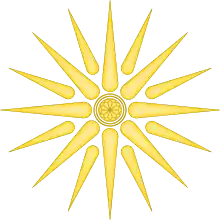Macedonian Bulgarians
Macedonians[3] or Macedonian Bulgarians[4] (Bulgarian: македонци or македонски българи), sometimes also referred to as Macedono-Bulgarians,[5] Macedo-Bulgarians,[6] or Bulgaro-Macedonians[7] are a regional, ethnographic group of ethnic Bulgarians,[8][9][10] inhabiting or originating from the region of Macedonia. Today, the larger part of this population is concentrated in Blagoevgrad Province but much is spread across the whole of Bulgaria and the diaspora.

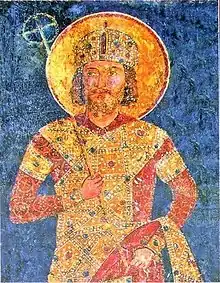
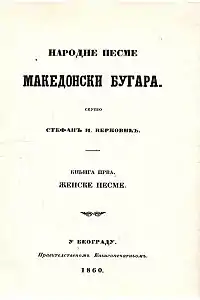
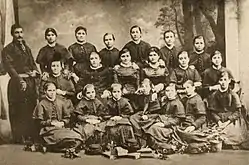
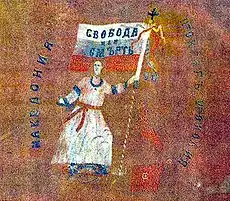

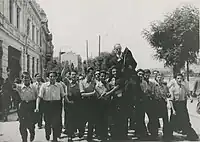
| Part of a series on |
| Bulgarians Българи |
|---|
 |
| Culture |
| By country |
| Subgroups |
| Religion |
| Language |
| Other |
|
History
Ottoman period
The Slavic-speaking population in the region of Macedonia had been referred to both (by themselves and outsiders) as Bulgarians, and that is how they were predominantly seen since 10th,[11][12][13] up until the early 20th century.[14] According to Encyclopædia Britannica, at the beginning of the 20th century the Macedonian Bulgarians constituted the majority of the population in the whole region of Macedonia, then part of the Ottoman Empire.[15] The functioning of the Bulgarian Exarchate then aimed specifically at differentiating the Bulgarian from the Greek and Serbian populations on an ethnic and linguistic basis, providing the open assertion of a Bulgarian national identity.[16] However one basic distinction between the political agendas of local intelligentsias was clear. The Macedonian Greeks and Serbs followed, in general, the directives coming from their respective centers of national agitation, while by the Bulgarians the term Macedonian was acquiring the significance of a certain political loyalty, that progressively constructed a particular spirit of regional identity.[17]
After the Balkan wars
The Balkan Wars (1912–1913) and World War I (1914–1918) left Ottoman Macedonia divided between Greece, Serbia and Bulgaria and resulted in significant changes in its ethnic composition. The immediate effect of the partition of Ottoman Macedonia were the nationalistic campaigns in areas under Greek and Serbian administration, which expelled Bulgarian churchmen and teachers and closed Bulgarian schools and churches. As a consequence a sizable part of the Slavic population of Greek and Serbian (later Yugoslav Macedonia), fled to Bulgaria or was resettled there by virtue of a population exchange agreements (Treaty of Neuilly-sur-Seine, Politis-Kalfov Protocol). Within Greece, the Macedonian Slavs were designated "Slavophone Greeks", while within Serbia (later within Yugoslavia) they were officially treated as "South Serbs". In both countries, schools and the media were used to disseminate the national ideologies and identities, and also the languages, of the new ruling nations, the Greeks and the Serbs. These cultural measures were reinforced by steps to alter the composition of the population: Serb colonists were implanted in Yugoslav Macedonia, while in Greek Macedonia, the mass settlement of Greek refugees from Anatolia definitively reduced the Slav population to minority status.[18]
Formation of a separate Macedonian identity
Despite some attempts to differentiate a Slavic Macedonian identity from the Bulgarian one since the end of the 19th century, and despite the nebulous national consciousness of the mass of the Slavic population, most researchers agree that the bulk of the Slavic population in the region had a Bulgarian national identity until the early 1940s, when the Bulgarian troops, occupying most of the area, were greeted as liberators.[19] Pro-Bulgarian feelings among the local Slavic population prevailed in Greece and Yugoslavia.[20] After the Second World War and Bulgarian withdrawal, on the base of the strong Macedonian regional identity a process of ethnogenesis started and distinct national Macedonian identity was formed.[21] As a whole an appreciable Macedonian national consciousness prior to the 1940s did not exist.[22][23][24] At that time even the political organization by the Slavic immigrants from the region of Macedonia, the Macedonian Patriotic Organization has also promoted the idea of Macedonian Slavs being Bulgarians.[25] The nation-building process was politically motivated and later reinforced by strong Bulgarophobia and Yugoslavism.[26] The new authorities began a policy of removing of any Bulgarian influence and creating a distinct Slavic consciousness that would inspire identification with Yugoslavia.[21]
With the proclamation of the new Socialist Republic of Macedonia, there were measures taken that would overcome the pro-Bulgarian feeling among the population.[27] It has been claimed that from 1944 till the end of the 1940s people espousing a Bulgarian ethnic identity had been oppressed.[27][28] According to Bulgarian sources more than 100,000 men were imprisoned and some 1,200 prominent Bulgarians were sentenced to death.[27][28] In addition, the inconsistent policy towards the Macedonian Bulgarians followed by Communist Bulgaria at that time has thrown most independent observers ever since into a state of confusion, as to the real ethnicity of the population even in Bulgarian Macedonia.[29][30] Practically as a consequence the rest of this people, with exception of Bulgaria proper, were eventually Macedonized or Hellenized.[31]
Nevertheless, people with Bulgarian consciousness or Bulgarophile sentiments still live in North Macedonia and Greece.[32][33] During the last years the EU membership of Bulgaria has seen more than 50,000 Macedonians applying for Bulgarian citizenship.[34] In order to obtain it they must sign a statement declaring they are Bulgarians by origin. More than 90,000 Macedonian nationals have already received Bulgarian citizenship.[35] However, this phenomenon can not give precise information about how many Macedonian nationals consider themselves Bulgarians in ethnic sense, because it is widely believed that this phenomenon is caused primarily for economic reasons.[36]
Historical Demographics
In the Ottoman General Census of 1881/82, the Orthodox Christian population of the kazas currently falling within the borders of the Republic of North Macedonia identified, as follows:
| Kaza1 | Bulgarian Exarchist |
Greek/Serbian Patriarchist | ||||||||||||||
|---|---|---|---|---|---|---|---|---|---|---|---|---|---|---|---|---|
| Number | % | Number | % | |||||||||||||
| Köprülü / Veles | 32,843 | 98.7 | 420 | 1.3 | ||||||||||||
| Tikveş | 21,319 | 98.8 | 260 | 1.2 | ||||||||||||
| Gevgili / Gevgelija | 5,784 | 28.4 | 14,558 | 71.6 | ||||||||||||
| Toyran / Dojran | 5,605 | 77.0 | 1,591 | 22.1 | ||||||||||||
| Usturumca/ Strumica | 2,974 | 17.8 | 13,726 | 82.2 | ||||||||||||
| Üsküp / Skopje | 22,497 | 77.2 | 6,655 | 22.8 | ||||||||||||
| Karatova / Kratovo | 19,618 | 81.8 | 4,332 | 18.1 | ||||||||||||
| Kumanova / Kumanovo | 29,478 | 70.1 | 12,268 | 29.9 | ||||||||||||
| Planka/ Kriva Palanka | 18,196 | 97.9 | 388 | 2.1 | ||||||||||||
| İştip / Štip | 17,575 | 100 | 0 | - | ||||||||||||
| Kaçana / Kočani | 33,120 | 99.8 | 83 | 0.8 | ||||||||||||
| Radovişt / Radoviš | 7,364 | 100.0 | 0 | - | ||||||||||||
| Kalkandelen / Tetovo | 9,830 | 66.3 | 4,990 | 33.7 | ||||||||||||
| Monastir / Bitola | 61,494 | 60.0 | 41,077 | 40.0 | ||||||||||||
| Ohri / Ohrid | 33,306 | 91.6 | 3,049 | 8.4 | ||||||||||||
| Pirlepe / Prilep | 43,763 | 97.2 | 1,248 | 2.8 | ||||||||||||
| Kirçova / Kičevo | 20,879 | 99.7 | 64 | 0.3 | ||||||||||||
| Republic of North Macedonia borders | 385,645 | 81.4 | 88,229 | 18.6 | ||||||||||||
1 The kaza of Dibra did not participate in the census. | ||||||||||||||||
See also
References
- National military history museum of Bulgaria, fond 260
- Who are the Macedonians by Hugh Poulton - p. 57. Retrieved 29 November 2014.
- South Slavic immigration in America, George J. Prpic, John Carroll University, Twayne Publishers. A division of G. K. Hall & Co., Boston., 1978, ISBN 0-8057-8413-6, p. 212.
- Harvard encyclopedia of American ethnic groups, Stephan Thernstrom, Ann Orlov, Oscar Handlin Edition: 2, Published by Harvard University Press, 1980 ISBN 0-674-37512-2, p. 691.
- Minderheiten und Sprachkontakt, Ulrich Ammon, Peter H Nelde, Klaus J Mattheier, Published by Niemeyer, 1990, ISBN 3-484-60346-1, p. 143.
- The Cambridge history of Turkey: Turkey in the modern world, Reşat Kasaba, Cambridge University Press, 2008, ISBN 0-521-62096-1,p. 107.
- Marinov, Tchavdar (2009). "We, the Macedonians: The Paths of Macedonian Supra-Nationalism (1878–1912)". In Diana Mishkova (ed.). We, the People: Politics of National Peculiarity in Southeastern Europe. Budapest / New York: CEU Press. p. 116.
- Етнография на Македония (Извори и материали в два тома), Автор: Колектив под редакцията на доц. Маргарита Василева, Обем: 853 стр. Издател: Българска Академия на Науките, Година: 1992.
- Sources of Bulgarian Ethnography. Volume 3. Ethnography of Macedonia. Materials from the Archive Heritage. Sofia, 1998; Publication: Ethnologia Bulgarica. Yearbook of Bulgarian Ethnology and Folklore (2/2001) Author Name: Nikolova, Vanya; Language: English, Subject: Anthropology, Issue: 2/2001,Page Range: 143-144
- Groups of Bulgarian population and ethnographic groups, Publication: Bulgarian Ethnology (3/1987ч Author: Simeonova, Gatya; Language: Bulgarian, Subject: Anthropology, Issue: 3/1987, Page Range: 55-63
- Who are the Macedonians? Hugh Poulton, C. Hurst & Co. Publishers, 2000, ISBN 1-85065-534-0, p. 19-20.
- Средновековни градови и тврдини во Македонија, Иван Микулчиќ, Македонска академија на науките и уметностите – Скопје, 1996, стр. 72.
- Formation of the Bulgarian Nation, Academician Dimitŭr Simeonov Angelov, Summary, Sofia-Press, 1978, pp. 413–415.
- Center for Documentation and Information on Minorities in Europe, Southeast Europe (CEDIME-SE) – "Macedonians of Bulgaria", p. 14. Archived 2006-07-23 at the Wayback Machine
- Bulgarians (described in encyclopaedia as "Slavs, the bulk of which is regarded by almost all independent sources as Bulgarians"): 1,150,000, whereof, 1,000,000 Orthodox and 150,000 Muslims (the so-called Pomaks); Turks: c. 500,000 (Muslims); Greeks: c. 250,000, whereof c. 240,000 Orthodox and 14,000 Muslims; Albanians: c. 120,000, whereof 10,000 Orthodox and 110,000 Muslims; Vlachs: c. 90,000 Orthodox and 3,000 Muslims; Jews: c. 75,000; Roma: c. 50,000, whereof 35,000 Orthodox and 15,000 Muslims; In total 1,300,000 Christians (almost exclusively Orthodox), 800,000 Muslims, 75,000 Jews, a total population of c. 2,200,000 for the whole of Macedonia.
- Journal of Modern Greek Studies 14.2 (1996) 253-301 Nationalism and Identity Politics in the Balkans: Greece and the Macedonian Question by Victor Roudometof.
- We, the People: Politics of National Peculiarity in Southeastern Europe, Diana Mishkova, Central European University Press, 2008, ISBN 963-9776-28-9, p. 108.
- Nationality on the Balkans. The case of the Macedonians, by F. A. K. Yasamee. (Balkans: A Mirror of the New World Order, Istanbul: EREN, 1995; pp. 121-132.
- The struggle for Greece, 1941–1949, Christopher Montague Woodhouse, C. Hurst & Co. Publishers, 2002, ISBN 1-85065-492-1, p. 67.
- Who are the Macedonians? Hugh Poulton, Hurst & Co., 1995, ISBN 978-1-85065-238-0, pp. 101; p. 109.
- Europe since 1945. Encyclopedia by Bernard Anthony Cook. ISBN 0-8153-4058-3, p. 808.
- Loring M. Danforth, The Macedonian Conflict: Ethnic Nationalism in a Transnational World, 1995, Princeton University Press, p.65, ISBN 0-691-04356-6
- Stephen Palmer, Robert King, Yugoslav Communism and the Macedonian question,Hamden, CT Archon Books, 1971, p.p.199-200
- The Macedonian Question: Britain and the Southern Balkans 1939-1949, Dimitris Livanios, edition: Oxford University Press, US, 2008, ISBN 0-19-923768-9, p. 65.
- The Macedonian Conflict: Ethnic Nationalism in a Transnational World, Page 87 by Loring M. Danforth.
- Mirjana Maleska. Editor-in-chief. With eyes of the others - about Macedonian-Bulgarian relations and the Macedonian national identity. New Balkan Politics - Journal of Politics. Issue 6. Archived 2007-09-24 at the Wayback Machine
- Djokić, Dejan (2003). Yugoslavism: Histories of a Failed Idea, 1918-1992. C. Hurst & Co. Publishers. p. 122. ISBN 1-85065-663-0.
- Phillips, John (2004). Macedonia: Warlords and Rebels in the Balkans. I.B.Tauris. p. 40. ISBN 1-86064-841-X.
- V, Joseph. The Communist Party of Bulgaria; Origins and Development, 1883-1936. Columbia University Press. p. 126.
- Coenen-Huther, Jacques (1996). Bulgaria at the Crossroads. Nova Publishers. p.166. ISBN 1-56072-305-X.
- Greece and the new Balkans: challenges and opportunities, Van Coufoudakis, Harry J. Psomiades, André Gerolymatos, Pella Pub. Co., 1999, ISBN 0-918618-72-X, p. 361.
- Yugoslavism: histories of a failed idea, 1918–1992, Dejan Djokić, C. Hurst & Co. Publishers, 2003, ISBN 1-85065-663-0, p. 122.
- Проф. д-р на ист.н. Георги Димитров Даскалов, "Българите в Егейска Македония - мит или реалност", Историко- демографско изследване (1900-1990 г.). С., Македонски научен институт, София, 1996 г. Professor Georgi Daskalov, The Bulgarians in Aegean Macedonia - myth or reality; Historical-Demographic research (1900-1990 г.), С. Macedonian Scientific Institute, Sofia, 1996, ISBN 954-8187-27-2.
- 53.000 МАКЕДОНЦИ ЧЕКААТ БУГАРСКИ ПАСОШ, ВЛАСТИТЕ САКААТ ДА ГО СКРАТАТ РОКОТ НА 6 МЕСЕЦИ
- Над 70 000 македонци имат българско гражданство
- Michael Palairet, Macedonia: A Voyage through History (Vol. 2, From the Fifteenth Century to the Present), Cambridge Scholars Publishing, 2016, ISBN 1443888494, p. 347.
- Karpat, K.H. (1985). Ottoman population, 1830-1914: demographic and social characteristics. Madison, Wis: University of Wisconsin Pres. p. 134-135, 140-141, 144-145.
